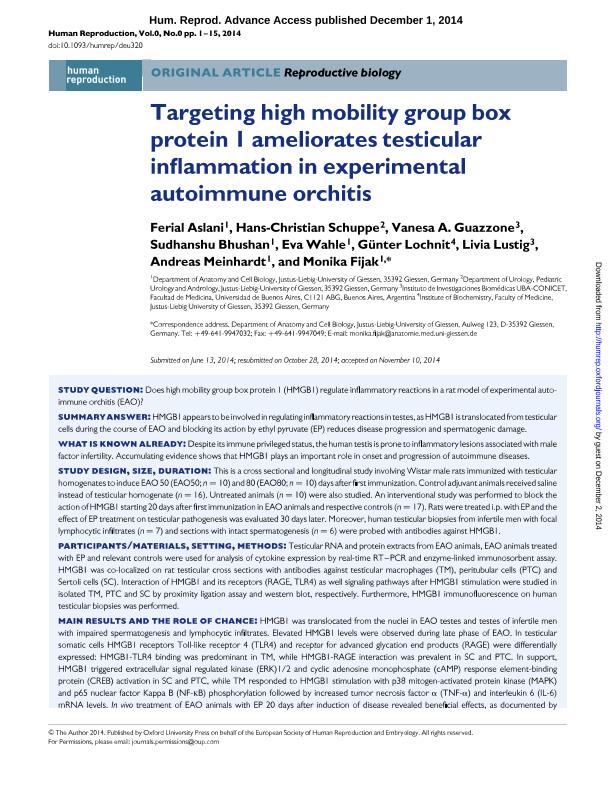Mostrar el registro sencillo del ítem
dc.contributor.author
Aslani, Ferial
dc.contributor.author
Schuppe, Hans-Christian
dc.contributor.author
Guazzone, Vanesa Anabella

dc.contributor.author
Bhushan, Sudhanshu
dc.contributor.author
Wahle, Eva
dc.contributor.author
Lochnit, Günter
dc.contributor.author
Lustig, Livia

dc.contributor.author
Meinhardt, Andreas
dc.contributor.author
Fijak, Monika
dc.date.available
2017-04-11T21:07:13Z
dc.date.issued
2015-02
dc.identifier.citation
Aslani, Ferial; Schuppe, Hans-Christian; Guazzone, Vanesa Anabella; Bhushan, Sudhanshu; Wahle, Eva; et al.; Targeting high mobility group box protein 1 ameliorates testicular inflammation in experimental autoimmune orchitis.; Oxford University Press; Human Reproduction; 30; 2; 2-2015; 417-431
dc.identifier.issn
0268-1161
dc.identifier.uri
http://hdl.handle.net/11336/15192
dc.description.abstract
STUDY QUESTION: Does high mobility group box protein 1 (HMGB1) regulate inflammatory reactions in a rat model of experimental autoimmune orchitis (EAO)? SUMMARY ANSWER: HMGB1 appears to be involved in regulating inflammatory reactions in testes, as HMGB1 is translocated from testicular cells during the course of EAO and blocking its action by ethyl pyruvate (EP) reduces disease progression and spermatogenic damage. WHAT IS KNOWN ALREADY: Despite its immune privileged status, the human testis is prone to inflammatory lesions associated with male factor infertility. Accumulating evidence shows that HMGB1 plays an important role in onset and progression of autoimmune diseases. STUDY DESIGN, SIZE, DURATION: This is a cross sectional and longitudinal study involving Wistar male rats immunized with testicular homogenates to induce EAO 50 (EAO50; n = 10) and 80 (EAO80; n = 10) days after first immunization. Control adjuvant animals received saline instead of testicular homogenate (n = 16). Untreated animals (n = 10) were also studied. An interventional study was performed to block the action of HMGB1 starting 20 days after first immunization in EAO animals and respective controls (n = 17). Rats were treated i.p. with EP and the effect of EP treatment on testicular pathogenesis was evaluated 30 days later. Moreover, human testicular biopsies from infertile men with focal lymphocytic infiltrates (n = 7) and sections with intact spermatogenesis (n = 6) were probed with antibodies against HMGB1. PARTICIPANTS/MATERIALS, SETTING, METHODS: Testicular RNA and protein extracts from EAO animals, EAO animals treated with EP and relevant controls were used for analysis of cytokine expression by real-time RT–PCR and enzyme-linked immunosorbent assay. HMGB1 was co-localized on rat testicular cross sections with antibodies against testicular macrophages (TM), peritubular cells (PTC) and Sertoli cells (SC). Interaction of HMGB1 and its receptors (RAGE, TLR4) as well signaling pathways after HMGB1 stimulation were studied in isolated TM, PTC and SC by proximity ligation assay and western blot, respectively. Furthermore, HMGB1 immunofluorescence on human testicular biopsies was performed. MAIN RESULTS AND THE ROLE OF CHANCE: HMGB1 was translocated from the nuclei in EAO testes and testes of infertile men with impaired spermatogenesis and lymphocytic infiltrates. Elevated HMGB1 levels were observed during late phase of EAO. In testicular somatic cells HMGB1 receptors Toll-like receptor 4 (TLR4) and receptor for advanced glycation end products (RAGE) were differentially expressed: HMGB1-TLR4 binding was predominant in TM, while HMGB1-RAGE interaction was prevalent in SC and PTC. In support, HMGB1 triggered extracellular signal regulated kinase (ERK)1/2 and cyclic adenosine monophosphate (cAMP) response element-binding protein (CREB) activation in SC and PTC, while TM responded to HMGB1 stimulation with p38 mitogen-activated protein kinase (MAPK) and p65 nuclear factor Kappa B (NF-ĸB) phosphorylation followed by increased tumor necrosis factor α (TNF-α) and interleukin 6 (IL-6) mRNA levels. In vivo treatment of EAO animals with EP 20 days after induction of disease revealed beneficial effects, as documented by reduced disease progression and spermatogenic damage, lower macrophage numbers, as well as decreased concentrations of HMGB1 and IL-6 in the testis compared with EAO controls. LIMITATIONS, REASONS FOR CAUTION: The ability of HMGB1 to bind to a wide range of receptors makes it difficult to prevent its action by blockade of a specific receptor; therefore we applied EP, a drug preventing HMGB1 release from cells. Due to its mode of action EP decreases also the secretion of some other pro-inflammatory cytokines. Using isolated primary cells imposes limitations for cell transfection studies. As a compromise between purity and yield primary cells need to be isolated from animals of different age, which has to be considered when comparing their responses. WIDER IMPLICATIONS OF THE FINDINGS: HMGB1 could be a promising target in attenuating testicular damage caused by inflammatory reactions. STUDY FUNDING/COMPETING INTEREST(S): This study was supported by a research grant of the University Medical Centre Giessen and Marburg to M.F. and H.-C.S. A.M., H.-C.S. and M.F. are supported by the LOEWE focus group ‘MIBIE’ (Male infertility during infection & inflammation)—an excellence initiative of the government of the German state of Hessen. The authors have nothing to disclose.
dc.format
application/pdf
dc.language.iso
eng
dc.publisher
Oxford University Press

dc.rights
info:eu-repo/semantics/openAccess
dc.rights.uri
https://creativecommons.org/licenses/by-nc-sa/2.5/ar/
dc.subject
Testicular Inflammation
dc.subject
Experimental Autoimmune Orchitis
dc.subject
High Mobility Group Box Protein 1
dc.subject
Receptor for Advanced Glycation And Products
dc.subject
Ethyl Pyruvate
dc.subject.classification
Inmunología

dc.subject.classification
Medicina Básica

dc.subject.classification
CIENCIAS MÉDICAS Y DE LA SALUD

dc.title
Targeting high mobility group box protein 1 ameliorates testicular inflammation in experimental autoimmune orchitis.
dc.type
info:eu-repo/semantics/article
dc.type
info:ar-repo/semantics/artículo
dc.type
info:eu-repo/semantics/publishedVersion
dc.date.updated
2017-04-07T14:27:53Z
dc.journal.volume
30
dc.journal.number
2
dc.journal.pagination
417-431
dc.journal.pais
Reino Unido

dc.journal.ciudad
Oxford
dc.description.fil
Fil: Aslani, Ferial. Justus Liebig University Giessen; Alemania
dc.description.fil
Fil: Schuppe, Hans-Christian. Justus Liebig University Giessen; Alemania
dc.description.fil
Fil: Guazzone, Vanesa Anabella. Universidad de Buenos Aires. Facultad de Medicina; Argentina. Consejo Nacional de Investigaciones Científicas y Técnicas. Oficina de Coordinación Administrativa Houssay. Instituto de Investigaciones Biomédicas; Argentina; Argentina
dc.description.fil
Fil: Bhushan, Sudhanshu. Justus Liebig University Giessen; Alemania
dc.description.fil
Fil: Wahle, Eva. Justus Liebig University Giessen; Alemania
dc.description.fil
Fil: Lochnit, Günter. Justus Liebig University Giessen; Alemania
dc.description.fil
Fil: Lustig, Livia. Universidad de Buenos Aires. Facultad de Medicina; Argentina. Consejo Nacional de Investigaciones Científicas y Técnicas. Oficina de Coordinación Administrativa Houssay. Instituto de Investigaciones Biomédicas; Argentina; Argentina
dc.description.fil
Fil: Meinhardt, Andreas. Justus Liebig University Giessen; Alemania
dc.description.fil
Fil: Fijak, Monika. Justus Liebig University Giessen; Alemania
dc.journal.title
Human Reproduction

dc.relation.alternativeid
info:eu-repo/semantics/altIdentifier/doi/http://dx.doi.org/10.1093/humrep/deu320
dc.relation.alternativeid
info:eu-repo/semantics/altIdentifier/url/https://academic.oup.com/humrep/article-lookup/doi/10.1093/humrep/deu320
Archivos asociados
